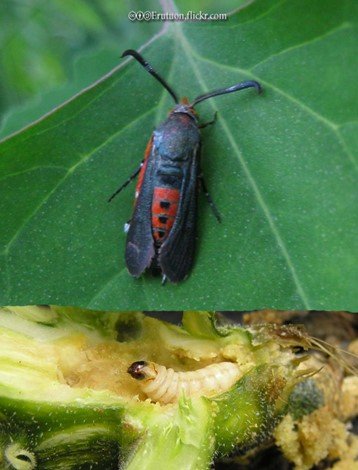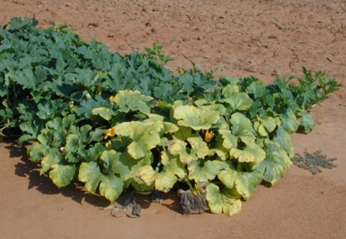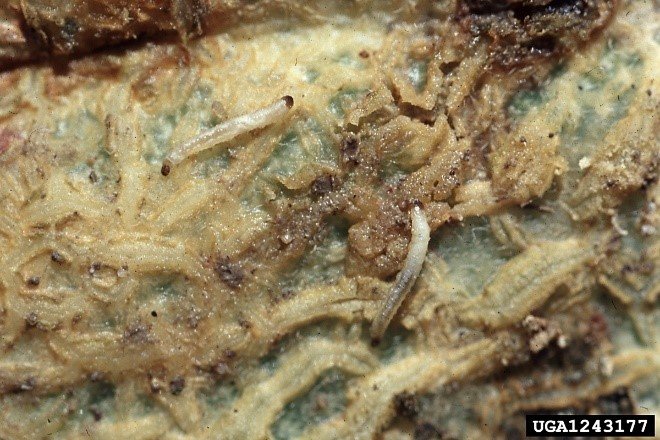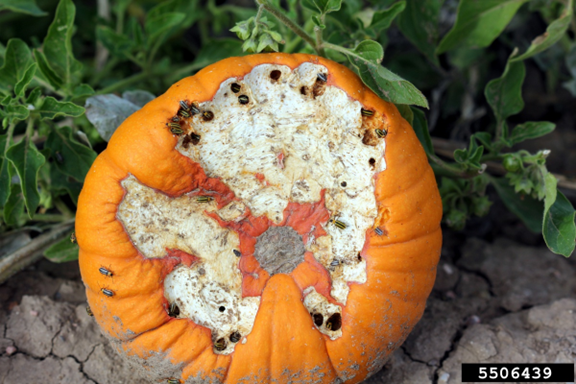All information and images on this page come from outside sources, as indicated.
Common cucurbit diseases, their vectors, and persistence. Table from Cornell University (2014). Link available by clicking the table.
Squash Vine Borer - They emerge in late April or early May. When cucurbits begin to flower, red and black moths lay shiny, mahogany brown eggs singly, usually on stems near plant bases. Caterpillars hatch in 1 to 2 weeks; they bore into stems and feed for about a month, then pupate in the soil. There are one or two generations a year. The pest overwinters underground as either a caterpillar or a pupa.
The bugs prefer squash, pumpkin, watermelon, cantaloupe, and cucumber, in that order.
Sources:



Squash Bug - The complete life cycle of the squash bug commonly requires six to eight weeks. The average egg length is about 1.5 mm and the width about 1.1 mm. Females deposit about 20 eggs in each egg cluster. There are five nymphal instars. The nymphal stage requires about 33 days for complete development. The adult measures 1.4 to 1.6 cm in length and is dark grayish brown to black in color. Adults are long-lived, surviving an average of about 75 to 130 days, depending on availability and quality of food. Squash bug adults are unusually difficult to kill with insecticides. Early-planted crops may be especially prone to attack. Numbers are also highest on plants during bloom and fruit set. The tendency of squash bugs to aggregate in sheltered locations can be used to advantage by home gardeners. Placement of boards, large cabbage leaves, or other shelter for squash bugs induces the bugs to congregate there during the day where they are easily found and crushed. Clean cultivation is essential to reduce the overwintering population.
Source: https://entnemdept.ufl.edu/creatures/veg/leaf/squash_bug.htm


Striped Cucumber Beetle – one of the most devastating pests of cucurbits (cucumbers, summer and winter squashes, all types of melons and pumpkins). Both adults and larvae feed on cucurbit crops. This insect is also responsible for the spread of plant diseases such as bacterial wilt and squash mosaic virus. Cantaloupes and muskmelons are especially vulnerable to bacterial wilt spread by the beetles. The insects overwinter as unmated adults in the neighboring areas of old cucurbit patches. Adults emerge in early spring before cucurbits are available as food, and feed on pollen, petals, and leaves of alternative hosts. Females deposit their eggs at the base of host plants, below the ground surface. Upon hatching (8-10 days) the larvae migrate to the root system and feed upon roots for 2-6 weeks, during which time they may consume the entire root system. Larvae pupate in the soil, emerging as adults in about one week. In fall, the adults return to the outlying areas for winter. Gardens may experience one to three generations of striped cucumber beetle in any given season (in New England areas). Rotate cucurbit crops. Cover planting beds with floating row covers immediately after planting seeds or setting out plants. Applying a heavy mulch of straw, leaves, or grass clippings around established plants may help reduce striped cucumber beetle attacks. Early in the growing season, check plants frequently for adult beetles or chewing damage on cucurbit stems and foliage. The most susceptible time is from crop emergence or transplanting until the plant has reached the 5-leaved stage.
Source: https://extension.unh.edu/resource/striped-cucumber-beetle-fact-sheet




